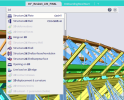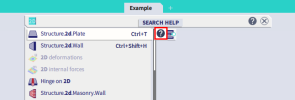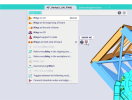SCIA Spotlight
The SCIA Spotlight is located at the top middle part of the screen (fixed location). It is a combination of a search functionality and a command line (input field). The user can click in it any time or just press the Space bar to start writing. The SCIA Spotlight has following capabilities:
-
functions can be activated via typing the appropriate command. Following page provides a List of commands;
-
when running a command in SCIA Engineer (regardless whether via the SCIA Spotlight, main menu, or toolbar button), SCIA Spotlights displays guiding instructions . This is very useful particularly for beginning users as they are clearly guided through the function they want to use and can simply follow the presented step-by-step instructions. From SCIA Engineer 22 on, the SCIA Spotlight will light up when a command is executed, so it is easier for users to read what to do as a next step;
- auto fill: the user can just start typing, usually only the first few letters will be enough to find what the user needs. When the command is auto filled, just hit enter to run it;
-
anything the user searches can the be directly accessed in the webhelp by the "?"-icon;
- the "Show me" feature allows the user to see where searched command is in the main menu. If the command is available in the main menu, the main menu opens automatically and the command is highlighted;
-
use SCIA Spotlight to customise the environment. Just as in the main menu, it is possible to drag-and-drop any searched command to the toolbars or to change its hotkey;
-
if any function requires a numerical input (e.g. co-ordinates of an inserted point), the corresponding value or values may be typed on the SCIA Spotlight. From SCIA Engineer 22 on you can directly start typing, since the SCIA Spotlight is automatically activated when a command is running.
- Depending on the command, a contextual menus could be offered just below the Spotlight
Syntax of commands
The syntax of a command to the command line is:
command parameter1 [parameter2] [parameter3] [etc.]
Example
SEL BEAM1
This command adds the 1D member named BEAM1 into the current selection.
Syntax for input of co-ordinates
The important thing to be aware of is that if a co-ordinate is typed by means of one or two numbers only, it is considered to be defined in the active working plane of the current user co-ordinate system.
If the point is defined by means of three values, it is considered to be defined in the current user co-ordinate system. In this case, the orientation of the working plane is not taken into account at all.
General syntax for the definition of a point
[prefix] [number] [separator] [number] [separator] [number]
Prefix
|
none |
absolute co-ordinate in UCS |
|
@ |
relative co-ordinate related to the last input point, defined in UCS |
|
* |
co-ordinate in GCS |
|
@* |
relative co-ordinate related to the last input point, defined in GCS |
Number
[space] [sign] [nnn] [.] [nnn] [exp] [sign] [nnn]
|
[space] |
if any, ignored |
|
[sign] |
sign plus or minus (‘+’ or ‘-‘) |
|
[nnn] |
row of digits 0,1, ..., 9 |
|
[,] |
decimal comma or point |
|
[exp] |
exponent – sign ‘e’ or ‘E’ |
Separator
|
; |
length value follows |
|
< |
angle value follows |
Syntax for the definition of a point in Cartesian co-ordinates
[*,@][X],[Y],[Z]
Examples
|
12.4;45.8;12.4 |
absolute point co-ordinate in UCS 12.4, 45.8, 12.4 |
|
123.4;345.8 |
absolute point co-ordinate in the current working plane of the UCS 123.4, 345.8 |
|
@123;23;5 |
relative co-ordinate related to the last inserted point in UCS 123, 23, 5 |
|
@123;23 |
relative co-ordinate related to the last inserted point in the current working plane of the UCS 123, 23 |
|
@123 |
relative co-ordinate related to the last inserted point in the current working plane of the UCS 123, 0 |
|
*123;23;5 |
global co-ordinate in GCS 123, 23, 5 |
|
* |
the origin of GCS 0, 0, 0 |
Syntax for the definition of a point in polar co-ordinates
[*,@][length]<[angle]
Examples
|
123<90 |
absolute co-ordinate of point in UCS 0, 123, 0 |
|
123<180 |
absolute co-ordinate of point in UCS 0, -123, 0 |
Syntax for the definition of a point in spherical co-ordinates
[*,@][length]<[ angle]<[angle]
Example
|
123<90<90 |
absolute co-ordinate of point in UCS 0, 0, 123 |
Syntax for the definition of a point in cylindrical co-ordinates
[*,@][length]<[angle],[length]
Example
|
123<90;200 |
absolute co-ordinate of point in UCS 0, 123, 20 |
Syntax for imperial units
If the imperial (fractional) units are used, the number must be terminated by a semicolon (;). Without this mark it is not possible to determinate where the number ends.
Examples of valid input in "feet":
8; = 0yd 8ft
12ft 8; = 0yd 12ft 8in
12ft 8in; = 0yd 12ft 8in
3yd 5; = 3yd 5ft 0in
3yd 6ft 8; = 3yd 6ft 8in
3yd 6ft 8in; = 3yd 6ft 8in
format without spaces also may be used :
8; = 0yd 8ft
12ft8; = 0yd 12ft 8in
12ft8in; = 0yd 12ft 8in
3yd5; = 3yd 5ft 0in
3yd6ft8; = 3yd 6ft 8in
3yd6ft8in; = 3yd 6ft 8in






